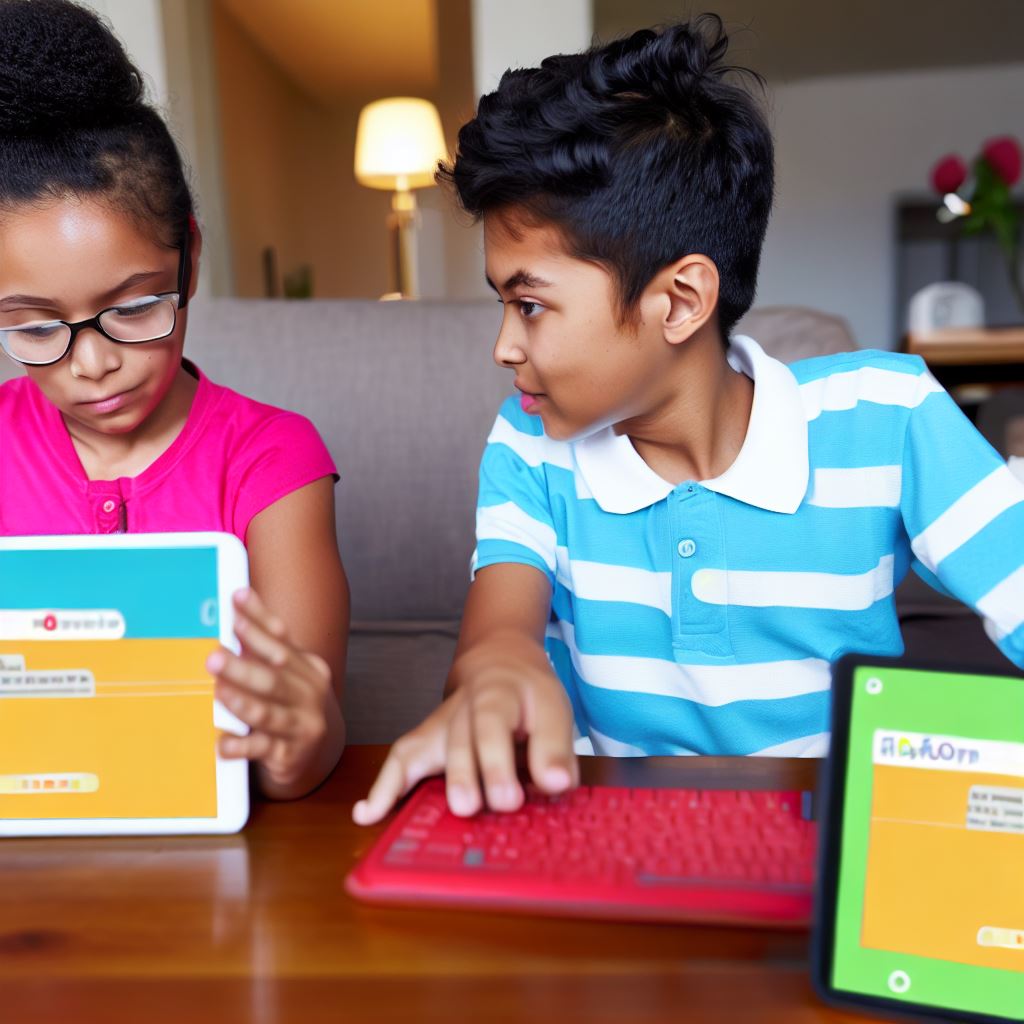Hour of Code: A Free Way to Introduce Kids to Coding
Last Updated on September 25, 2023
Introduction
The concept of Hour of Code
The Hour of Code is a program aimed at introducing kids to coding in an engaging way.
B. The importance of introducing coding to kids
It is important to introduce coding to children as part of their education to prepare them for the digital future.
C. The purpose of the blog post
The purpose of this blog post is to explore the benefits of the Hour of Code and encourage parents and educators to incorporate this initiative into their children’s learning journey.
Coding is becoming an essential skill in today’s world, as technology continues to advance at an exponential rate.
By introducing coding at an early age, children can develop problem-solving skills, logical thinking, and creativity.
The Hour of Code provides a free and accessible platform for kids to learn coding basics, without any prior experience required.
One of the main advantages of the Hour of Code is its user-friendly approach.
Kids are guided through interactive tutorials and games that make learning to code enjoyable and exciting.
They can explore various coding languages such as Scratch, JavaScript, and Python, gaining exposure to different programming concepts.
Moreover, coding encourages critical thinking, collaboration, and perseverance.
Through coding, children learn to break down complex tasks into smaller, manageable steps.
They also have the opportunity to collaborate with their peers, exchanging ideas and solving problems together. This fosters teamwork and communication skills.
By participating in the Hour of Code, children can also gain a sense of accomplishment and confidence in their abilities.
The program allows them to create and share their own projects, showcasing their creativity and innovation.
Basically, the Hour of Code is an excellent way to introduce kids to coding.
Its user-friendly approach and the benefits it provides, such as problem-solving skills and teamwork, make it a valuable educational initiative.
So why wait? Encourage your child or students to participate in the Hour of Code and open the doors to a world of opportunities.
What is Hour of Code?
A. Origins of Hour of Code
The Hour of Code is a free program that introduces kids to the world of coding.
The origins of Hour of Code can be traced back to 2013 when it was launched by Code.org.
It was created as a way to address the lack of computer science education in schools.
Hour of Code quickly grew into a global movement with millions of participants around the world.
Since its inception, Hour of Code has reached over 180 countries and has been translated into more than 45 languages.
It has become a popular initiative, attracting support from various organizations, including tech giants like Microsoft and Apple.
One of the reasons for its popularity is its easy accessibility – anyone with an internet connection can participate.
B. Benefits of Hour of Code
The program offers a wide variety of coding tutorials – from simple block-based programming to more advanced concepts.
These tutorials are designed to be engaging and interactive, providing a fun learning experience for kids.
Hour of Code has also gained recognition from educational institutions, with many schools incorporating it into their curriculum.
Teachers have reported positive outcomes from using Hour of Code in their classrooms.
Students who participate in Hour of Code develop critical thinking, problem-solving, and creativity skills.
Furthermore, coding can help improve math and logic skills, as well as foster a growth mindset.
There are countless success stories of kids who were inspired by Hour of Code to pursue further education or careers in computer science.
By exposing children to coding at an early age, Hour of Code aims to prepare them for the digital age.
In an increasingly technology-driven world, coding literacy is becoming an essential skill.
Hour of Code provides a stepping stone for kids to become proficient in coding and ultimately contribute to the digital landscape.
C. Implications of Hour of Cod to the Society
Participating in Hour of Code is not only beneficial for kids’ development, but it also has broader implications for society.
By equipping children with coding skills, we can bridge the digital divide and create a more inclusive future.
Hour of Code is an important initiative that is making coding accessible and fun for kids worldwide.
Its impact goes beyond the classroom, shaping the future of technology and inspiring the next generation of innovators.
Whether a child becomes a professional programmer or not, the skills gained from Hour of Code will undoubtedly be valuable in the digital era.
So, why not give your child the opportunity to participate in Hour of Code and unlock their potential in coding?
Join the global movement and let your child embark on an exciting journey into the world of coding with Hour of Code.
Read: Coding Classes for Kids: What Age is Right to Start?
Why Hour of Code is Important
A. Benefits of Learning Coding Early
Introducing kids to coding early sparks curiosity, critical thinking, and logical reasoning abilities.
Hands-on coding experience enhances computational skills, vital for academic success in STEM fields.
Early coders develop resilience, learning from their coding mistakes and iterating solutions – a valuable life skill.
B. Fostering Creativity and Problem-Solving
Coding ignites creativity by allowing kids to bring their imaginative ideas to life through programming.
Problem-solving becomes second nature as young coders tackle real-world challenges with code-based solutions.
The “Hour of Code” nurtures a growth mindset, encouraging kids to embrace challenges and explore innovative solutions.
C. Career Opportunities and Future Relevance
In our digital age, coding skills are indispensable, opening doors to diverse career options.
From software engineering to data science, coding knowledge equips children for tomorrow’s job market.
Tech-driven industries constantly demand coding expertise, ensuring the long-term relevance of this skill.
Generally, the “Hour of Code” isn’t merely an activity; it’s a gateway to a brighter future.
Early exposure to coding not only builds essential skills but also nurtures creativity, problem-solving, and prepares kids for a tech-driven job market.
So, let’s embrace this opportunity to empower our children with the skills they need to thrive in the digital age.
Read: How to Choose the Right Coding Language for Your Child
How Hour of Code Works
Hour of Code is a free online program that introduces kids to the world of coding.
It is a fun and interactive way for children to learn the basics of programming and computer science.
- Hour of Code provides a variety of activities and tutorials that are designed to engage and challenge kids.
- These activities range from simple coding puzzles to more complex projects that involve creating games or animations.
- The program caters to a wide range of ages, from elementary school children to high school students.
- Participants can choose from different themes and topics, such as creating their own Minecraft world or programming a Star Wars droid.
- Hour of Code utilizes a block-based coding interface, which makes it accessible and easy for beginners to understand.
- By dragging and dropping blocks of code, kids can build their own programs and see instant results.
- The program also offers guidance and tips to help children overcome challenges and improve their coding skills.
- Hour of Code encourages creativity and problem-solving, as kids experiment with different coding concepts and find solutions to various puzzles.
- It provides a supportive and interactive learning environment, allowing kids to learn at their own pace and explore their interests.
- Hour of Code is not limited to just one hour; participants can spend as much time as they want exploring different coding activities.
Who can Participate?
The Hour of Code program is suitable for kids of all ages.
It is designed to be accessible and engaging for beginners, without any prior coding experience.
The activities and tutorials are carefully crafted to introduce children to the fundamental concepts of programming and computational thinking.
Elementary school children can start with simple coding puzzles and learn the basics of sequencing, loops, and conditionals.
As they progress, they can explore more complex projects that involve problem-solving and logical thinking.
For middle and high school students, Hour of Code offers tutorials that delve into advanced coding concepts, such as variables, functions, and object-oriented programming.
They can challenge themselves by creating interactive games, designing websites, or even building mobile apps.
Hour of Code is not just for students; educators and parents can also participate to support and guide their children in their coding journey.
The program provides resources and materials specifically designed for teachers, making it easy to incorporate coding into the classroom curriculum.
The Hour of Code program has been widely embraced by schools around the world.
It has become a global movement, with millions of students participating each year during Computer Science Education Week.
Essentially, Hour of Code is an excellent opportunity for kids to explore the world of coding in a fun and interactive way.
It provides a wide range of activities and tutorials that cater to different ages and skill levels.
By participating in Hour of Code, children can develop important computational thinking skills and ignite their passion for coding.
Read: 5 Affordable Online Coding Courses for Your Kids

Success Stories
As an instructor who has participated in several Hour of Code events, I have witnessed numerous success stories and incredible achievements from kids who have taken part in this free initiative.
- A 10-year-old boy, Jake, joined Hour of Code with no prior coding experience. By the end of the event, he had created a simple game using Scratch.
- Emma, a 12-year-old girl, was initially hesitant about coding. After participating in Hour of Code, she discovered her passion for web development and is now pursuing it as a hobby.
- During a recent event, a group of elementary school students collaborated to develop a fully functional app that helped their school track recycling efforts.
A. Examples of Coding Projects
- Sarah, an 8-year-old, designed a personalized quiz using JavaScript, which tested her friends’ knowledge about animals.
- Mark, a 14-year-old, created a website from scratch during Hour of Code, showcasing his artwork and photography skills.
- A group of high school students developed a mobile app that connected volunteers with local charitable organizations.
B. Notable Results and Achievements
- During Hour of Code, more than 100,000 students worldwide were introduced to coding and expressed interest in pursuing it further.
- A study conducted after previous events showed that kids who participated in Hour of Code had improved problem-solving and critical thinking skills.
- Several companies noticed the talent showcased during Hour of Code and offered internships to some of the participating students.
The success stories mentioned above are just a small fraction of the remarkable outcomes that have resulted from Hour of Code.
This initiative has proven to be a gateway for children to explore the world of coding and discover their own potential.
Read: Why Every Child Should Learn to Code: A Parent’s Guide
How to Get Involved
The Hour of Code is a fantastic initiative that aims to introduce kids to coding in a fun and accessible way.
The best part is that it’s completely free! If you’re a parent, educator, or just someone interested in getting involved, there are several ways you can participate in this exciting event.
A. Getting Involved as a Parent
Parents play a crucial role in their child’s education, and the Hour of Code is a great opportunity to introduce them to the world of programming.
You can start by visiting the official Hour of Code website, where you’ll find a wealth of resources and activities.
One of the best ways to get your child involved is by setting aside an hour every day during the event for them to learn and explore coding.
You can also encourage their school to participate by reaching out to teachers or administrators.
If you’re unsure about how to teach your child coding, don’t worry!
The Hour of Code website offers step-by-step tutorials and guides for both parents and educators.
You can also find useful resources on other websites like Code.org and Scratch.
B. Getting Involved as an Educator
As an educator, you have a unique opportunity to inspire and engage your students in the world of coding.
The Hour of Code provides a perfect platform to do just that. To get started, visit the official website and explore the resources available to educators.
Consider integrating coding activities into your lesson plans during the event.
The Hour of Code materials are designed to complement existing curricula, making it easy for you to incorporate them into your classroom.
You can also organize coding competitions or challenges to further motivate your students.
If your school is unable to participate in the official Hour of Code event, you can still organize your own coding activities.
Reach out to other educators in your community and collaborate on organizing coding workshops or events.
This way, you can maximize the impact and reach of coding education in your area.
C. Getting Involved as a Kid
Are you a young aspiring coder?
The Hour of Code is perfect for you!
Visit the official website and explore the interactive tutorials and games designed specifically for kids.
You can learn to code with popular characters like Minecraft, Star Wars, and Frozen.
If you’re part of a school or a club, talk to your teacher or mentor about organizing an Hour of Code event.
You can also encourage your classmates and friends to participate or form coding teams to tackle challenges together.
Don’t forget to share your coding journey on social media using the official hashtags like #HourOfCode and #codingforkids.
This way, you can inspire and encourage other kids to get involved in coding too.
The Hour of Code is a fantastic opportunity for parents, educators, and kids to get involved in coding and technology.
By participating in this event, you are not only helping to introduce kids to a valuable skill but also opening doors to future opportunities and careers.
So, whether you’re a parent, educator, or a young coder, get involved, explore the resources available, and let the coding adventure begin!
Tips for a Successful Hour of Code Session
- Start by explaining the basics of coding and its relevance in today’s world.
- Provide examples of successful individuals in the field of coding to inspire the kids.
- Showcase different coding languages and their usefulness in different industries.
- Encourage kids to choose a coding activity that aligns with their interests.
- Ensure that each child has access to a computer or tablet for the session.
- Create a comfortable and distraction-free learning environment by organizing the space.
- Use headphones or provide quiet areas to minimize noise distractions.
- Prepare the necessary software or online platforms required for the coding activities.
- Start the session by giving a brief introduction to the chosen coding activity.
- Demonstrate the steps of the coding activity using a projector or screen sharing.
- Ask the students to follow along and provide assistance as needed.
- Encourage teamwork and collaboration by assigning group activities or challenges.
- Offer praise and positive reinforcement throughout the session to boost confidence.
- Highlight the importance of perseverance and problem-solving in coding.
- Create a friendly competition by rewarding the most creative or efficient solutions.
- Allow time for questions and discussions to clarify any misconceptions.
- Remind the kids that coding is a continuous learning process and mistakes are opportunities for growth.
- Suggest resources for further learning and practice after the Hour of Code session.
- Follow up with the kids, ensuring that they continue exploring coding beyond the session.
- Consider organizing coding clubs or workshops to foster continued interest in coding.
- Offer support and guidance to parents interested in helping their children continue coding at home.
By following these tips, you can ensure a successful Hour of Code session that introduces kids to the world of coding in a fun and engaging way.
Conclusion
The Hour of Code is a highly significant and valuable initiative that introduces children to the world of coding.
Throughout this blog post, we discussed the importance of coding skills in today’s digital age, the benefits of learning coding from a young age, and the accessibility of the Hour of Code program.
By participating in the Hour of Code, children not only develop essential coding skills, but they also cultivate problem-solving, critical thinking, and creativity.
This program provides a fun and engaging introduction to coding, making it accessible and enjoyable for kids of all backgrounds and abilities.
The Hour of Code offers a free opportunity for children to explore and learn coding in a supportive and interactive environment.
With its vast array of programming activities and resources, children can explore different coding languages and concepts.
We encourage our readers to take full advantage of the Hour of Code program and ensure that their children are introduced to coding at an early age.
By exposing kids to coding through this free opportunity, we can help shape their future and equip them with valuable skills for success in the digital world.
In a ntushell, the Hour of Code is a gateway to exciting possibilities, empowering children to become creators rather than mere consumers of technology.
Let us seize this free opportunity and inspire the next generation of innovative thinkers and problem solvers.


